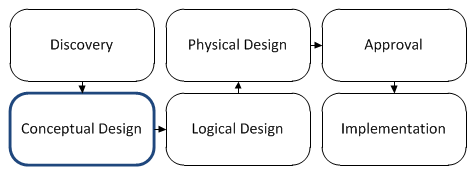During the vSphere design discovery process, information is collected on the business and technical goals of the virtualization project. This information must be analyzed in order to determine the vSphere design factors.
The vSphere design factors that must be determined are as follows:
- Requirements
- Constraints
- Assumptions
- Risks
Determining the requirements, making and proving assumptions, determining constraints, and identifying risks forms the conceptual design and provides the foundation to build on for the logical design. Business and technical design factors that are identified as part of the conceptual design will be mapped to the resources that are necessary to satisfy them during the logical design process. The conceptual design phase is highlighted within the overall design and implementation flow diagram:




